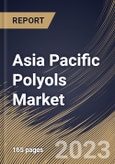Polyols have been utilized in numerous infrastructure development projects funded by government initiatives. They are used as a special component in the food and beverage industry and as a sugar replacement in various products, including confectionery, ice creams, fruit spreads, and yogurt. The consumer goods, electronics, footwear, and packaging industries significantly demand polyols, contributing significantly to the overall market growth. Moreover, these are widely employed in the building and construction industries. The significant increase in population has increased the demand for infrastructure and housing. This is expected to establish a robust market growth opportunity.
Polyether polyols are the predominant product segment in the formulation of PU adhesives. Compared to polyester polyols, polyether polyols offer superior flexibility at low temperatures and are less susceptible to hydrolysis. Additionally, polyether polyols are used to formulate reactive hot melt adhesives. Polyester polyols are extensively used in highly automated and hot-melting adhesive applications, demanding a quick setting time or initial green strengths. In addition, bio-based polyols are expected to be incorporated by major polyol producers in order to reduce reliance on conventional petrochemical-derived polyols and associated risks, such as environmental issues and fluctuating raw material prices.
As per the International Trade Administration, China is the world's largest automotive sector in yearly sales and manufacturing output, with domestic output estimated to exceed 35 million vehicles by 2025. According to information from the Ministry of Industry and Information Technology, approximately 26 million vehicles, including 21.48 million passenger cars, were sold in 2021, an increase of 7.1% from the previous year. Sales of commercial vehicles totaled 4.79 million, a 6.6% decrease from 2020. China's automotive industry has been experiencing rapid growth, leading to an increased demand for automotive seating and interior components. Polyurethane foams made from polyols are used extensively in car seats, dashboards, door panels, and headliners for their comfort, durability, and safety properties. Therefore, the aforementioned factors boost the growth of the market in this region.
The China market dominated the Asia Pacific Polyols Market by Country in 2022, and would continue to be a dominant market till 2030; thereby, achieving a market value of $10,317.6 million by 2030. The Japan market is registering a CAGR of 6.7% during (2023 - 2030). Additionally, The India market would showcase a CAGR of 7.4% during (2023 - 2030).
Based on End-use, the market is segmented into Building & Construction, Furnishings, Automotive, Packaging, Electronics, and Others. Based on Product, the market is segmented into Polyether, and Polyester. Based on Application, the market is segmented into Flexible Foam, Rigid Foam, Coatings, Adhesives & Sealants, Elastomers, and Others. Based on countries, the market is segmented into China, Japan, India, South Korea, Australia, Malaysia, and Rest of Asia Pacific.
The market research report covers the analysis of key stake holders of the market. Key companies profiled in the report include The Dow Chemical Company, BASF SE, Vertellus, Huntsman Corporation, Lanxess AG, Mitsui Chemicals, Inc., Stepan Company, Koch Industries, Inc. (Invista BV), Tosoh Corporation, and Shell plc.
Scope of the Study
Market Segments Covered in the Report:
By End-use (Volume, Kilo Tonnes, USD Million, 2019-2030)- Building & Construction
- Furnishings
- Automotive
- Packaging
- Electronics
- Others
- Polyether
- Polyester
- Flexible Foam
- Rigid Foam
- Coatings
- Adhesives & Sealants
- Elastomers
- Others
- China
- Japan
- India
- South Korea
- Australia
- Malaysia
- Rest of Asia Pacific
Key Market Players
List of Companies Profiled in the Report:
- The Dow Chemical Company
- BASF SE
- Vertellus
- Huntsman Corporation
- Lanxess AG
- Mitsui Chemicals, Inc.
- Stepan Company
- Koch Industries, Inc. (Invista BV)
- Tosoh Corporation
- Shell plc
Unique Offerings
- Exhaustive coverage
- The highest number of Market tables and figures
- Subscription-based model available
- Guaranteed best price
- Assured post sales research support with 10% customization free
Table of Contents
Companies Mentioned
- The Dow Chemical Company
- BASF SE
- Vertellus
- Huntsman Corporation
- Lanxess AG
- Mitsui Chemicals, Inc.
- Stepan Company
- Koch Industries, Inc. (Invista BV)
- Tosoh Corporation
- Shell plc
Methodology

LOADING...








